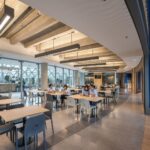Redefining Architectural Design for LNG Facilities

Understanding LNG’s Significance
Liquified Natural Gas (LNG) stands as a vital alternative energy source globally, offering a solution to the ongoing energy crisis. In response, the architectural design of the Nong Fab LNG Receiving Terminal aims to educate visitors on LNG’s significance, production process, and associated benefits.
 Embodying the LNG Tank Environment
Embodying the LNG Tank Environment
Central to the design concept is replicating the unique environment of an LNG tank within the facility. The main office space mirrors the dimensions of the LNG tank, creating an immersive experience for visitors. To mitigate the imposing scale of the tank and integrate it harmoniously with the landscape, natural elements are woven throughout the space, culminating in a green roof that blends seamlessly with the surroundings.
Sustainable Integration and Environmental Conservation
Efforts are made to harness the by-product cool air from the LNG regasification process, repurposing it to regulate the building’s temperature. This innovative approach not only enhances energy efficiency but also facilitates the cultivation of cold climate flora year-round, contributing to environmental sustainability.
 Harmonizing with Nature
Harmonizing with Nature
Externally, the architectural design prioritizes integration with the natural environment. The preservation and restoration of the original wetland ecosystem, along with native Fab trees, are central to the project. Moreover, the recreation of the water flow system and the establishment of a large pond serve to rejuvenate the ecosystem and mitigate environmental damage.
By reimagining architectural design principles and prioritizing sustainability and environmental conservation, the Nong Fab LNG Receiving Terminal sets a new standard for LNG facilities, emphasizing education, integration with nature, and energy efficiency.

























